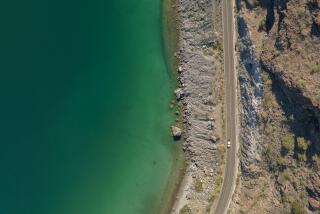Search for Coronado’s Trail Becomes Wild-Goose Chase
- Share via
WICHITA, Kan. — Scholars are having trouble putting Francisco Vasquez de Coronado on the map.
They want to add the 16th-Century Spaniard’s route through the Southwest to the National Trails System, but they are not getting much help from the explorer and his party.
“Coronado and his men had no idea where they had gone. They were marching off the end of the known world,” said Don Blakeslee, Wichita State University anthropology department chairman.
Blakeslee and Betty Romero, director of the Rice County Coronado-Quivira Museum in Lyons, are coordinating the project for the Coronado Trail Assn.
They have been combing historical documents--including letters Coronado wrote the king of Spain and accounts by participants--in hopes of determining which of 30 proposed routes is the right one.
“There are plenty of people who have a pet idea where he went,” Blakeslee said. “Every little town anywhere near where he might have gone would like to be able to claim Coronado.”
In 1540, Coronado and his entourage--300 soldiers and about 1,500 Indian guides and camp followers--set out from Mexico to search for the legendary gold-rich Seven Cities of Cibola.
For two years, together and in separate groups, they explored Arizona, New Mexico, Texas, Oklahoma and Kansas. Though they found no gold, they helped open the region to colonization.
Romero says she wants her museum to become an interpretive center for the trail. In April, the museum will sponsor a symposium for scholars to view exhibits of armor and weapons used by the conquistadors and debate where Coronado and his men traveled.
“We’re going to try to throw out as many wrong ideas as we can in a short period of time,” Blakeslee said. “But we haven’t yet gotten all of the people together who need to be in one room arguing with one another. And we haven’t done all of the field work, which is absolutely critical.”
Blakeslee said the field work could quickly eliminate some routes.
One proposed path the anthropology professor checked was obviously wrong. He said he crossed the Cimarron River where the route’s proponent said Coronado crossed. But the canyon the explorers described was not there.
Coronado’s letters and the other texts offer clues but few definite directions.
Ambiguities in the texts also have frustrated scholars, Blakeslee said.
In one passage, the explorers wrote about eating nuts growing in the area they were traveling through but did not say what kind of nuts. One person assumed the nuts were pecans and based a proposed route on that assumption, Blakeslee said.
“You can’t base your arguments on assumptions,” he said. “You have to base them on something in the texts. Then you can make an assumption, if there is any way to test it.”
Romero and Blakeslee are hoping new information on Indian trails may play a big role in assembling the jigsaw puzzle that previously had critical pieces missing.
Coronado had Indian guides who apparently knew the country because they were able to lead the hundreds of soldiers to good water every night of their travels in August in southwestern Kansas, Blakeslee said.
By using historical accounts, old maps, letters and other documents, Blakeslee has established locations for many Indian trails in the Great Plains.
Just about everything important in the early history of the Plains happened along established trails, he said.
Most of the eight trails already in the system, including the Santa Fe Trail in Kansas, were established along precisely known routes, Blakeslee said. Some trails are still marked by wagon ruts or other physical features.
More to Read
Sign up for Essential California
The most important California stories and recommendations in your inbox every morning.
You may occasionally receive promotional content from the Los Angeles Times.













